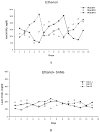The cyclic pattern of blood alcohol levels during continuous ethanol feeding in rats: the effect of feeding S-adenosylmethionine
- PMID: 20303346
- PMCID: PMC2888598
- DOI: 10.1016/j.yexmp.2010.03.004
The cyclic pattern of blood alcohol levels during continuous ethanol feeding in rats: the effect of feeding S-adenosylmethionine
Abstract
S-adenosylmethionine (SAMe), the major methyl donor for DNA and histone methylation was fed with ethanol for 1month in order to modify the effects of ethanol on rat liver. The following parameters were studied to determine the effects of SAMe; liver histology, the blood alcohol cycle (BAL), changes in gene expression mined from microarray analysis, changes in histone methylation, changes in liver SAMe levels and its metabolites and ADH. SAMe changed the type of fatty liver, reduced liver ALT levels and prevented the BAL cycle caused by intragastric ethanol feeding. Microarray analysis showed that SAMe feeding prevented most of the changes in gene expression induced by ethanol feeding, presumably by inducing H3K27me3 and gene silencing. H3K27me3 was significantly increased by SAMe with or without ethanol feeding. It is concluded that SAMe feeding stabilized global gene expression so that the changes in gene expression involved in the blood alcohol cycle were prevented.
Copyright 2010 Elsevier Inc. All rights reserved.
Figures








Similar articles
-
S-adenosylmethionine prevents the up regulation of Toll-like receptor (TLR) signaling caused by chronic ethanol feeding in rats.Exp Mol Pathol. 2011 Jun;90(3):239-43. doi: 10.1016/j.yexmp.2011.01.005. Epub 2011 Jan 25. Exp Mol Pathol. 2011. PMID: 21276439 Free PMC article.
-
Betaine feeding prevents the blood alcohol cycle in rats fed alcohol continuously for 1 month using the rat intragastric tube feeding model.Exp Mol Pathol. 2011 Oct;91(2):540-7. doi: 10.1016/j.yexmp.2011.05.009. Epub 2011 Jun 25. Exp Mol Pathol. 2011. PMID: 21708146 Free PMC article.
-
The effect of propranolol on gene expression during the blood alcohol cycle of rats fed ethanol intragastrically.Exp Mol Pathol. 2010 Feb;88(1):32-7. doi: 10.1016/j.yexmp.2009.11.003. Epub 2009 Nov 17. Exp Mol Pathol. 2010. PMID: 19925788 Free PMC article.
-
Alcoholic liver disease and methionine metabolism.Semin Liver Dis. 2009 May;29(2):155-65. doi: 10.1055/s-0029-1214371. Epub 2009 Apr 22. Semin Liver Dis. 2009. PMID: 19387915 Review.
-
The pathogenesis and significance of the urinary alcohol cycle in rats fed ethanol intragastrically.Alcohol Clin Exp Res. 2005 Nov;29(11 Suppl):158S-161S. Alcohol Clin Exp Res. 2005. PMID: 16344601 Review.
Cited by
-
S-adenosylmethionine prevents the up regulation of Toll-like receptor (TLR) signaling caused by chronic ethanol feeding in rats.Exp Mol Pathol. 2011 Jun;90(3):239-43. doi: 10.1016/j.yexmp.2011.01.005. Epub 2011 Jan 25. Exp Mol Pathol. 2011. PMID: 21276439 Free PMC article.
-
SAMe treatment prevents the ethanol-induced epigenetic alterations of genes in the Toll-like receptor pathway.Exp Mol Pathol. 2013 Feb;94(1):243-6. doi: 10.1016/j.yexmp.2012.09.024. Epub 2012 Oct 6. Exp Mol Pathol. 2013. PMID: 23047067 Free PMC article.
-
Epigenetic regulation of miR-34a expression in alcoholic liver injury.Am J Pathol. 2012 Sep;181(3):804-17. doi: 10.1016/j.ajpath.2012.06.010. Epub 2012 Jul 25. Am J Pathol. 2012. PMID: 22841474 Free PMC article.
-
The good, the bad, and the ugly with alcohol use and abuse on the heart.Alcohol Clin Exp Res. 2013 Aug;37(8):1253-60. doi: 10.1111/acer.12109. Epub 2013 Mar 25. Alcohol Clin Exp Res. 2013. PMID: 23527963 Free PMC article. Review.
-
Proteasome inhibitor treatment reduced fatty acid, triacylglycerol and cholesterol synthesis.Exp Mol Pathol. 2012 Aug;93(1):26-34. doi: 10.1016/j.yexmp.2012.03.006. Epub 2012 Mar 16. Exp Mol Pathol. 2012. PMID: 22445925 Free PMC article.
References
-
- Bardag-Gorce F, et al. The importance of cycling of blood alcohol levels in the pathogenesis of experimental alcoholic liver disease in rats. Gastroenterology. 2002;123:325–335. - PubMed
-
- Bradford MM. A rapid and sensitive method for the quantification of microgram quantities of protein utilizing the principle of protein-dye binding. Anal Biochem. 1976;72:248–254. - PubMed
Publication types
MeSH terms
Substances
Grants and funding
LinkOut - more resources
Full Text Sources

